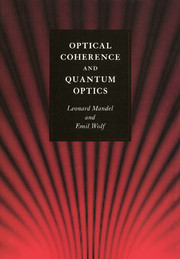Book contents
- Frontmatter
- Contents
- Preface
- 1 Elements of probability theory
- 2 Random (or stochastic) processes
- 3 Some useful mathematical techniques
- 4 Second-order coherence theory of scalar wavefields
- 5 Radiation from sources of any state of coherence
- 6 Second-order coherence theory of vector electromagnetic fields
- 7 Some applications of second-order coherence theory
- 8 Higher-order correlations in optical fields
- 9 Semiclassical theory of photoelectric detection of light
- 10 Quantization of the free electromagnetic field
- 11 Coherent states of the electromagnetic field
- 12 Quantum correlations and photon statistics
- 13 Radiation from thermal equilibrium sources
- 14 Quantum theory of photoelectric detection of light
- 15 Interaction between light and a two-level atom
- 16 Collective atomic interactions
- 17 Some general techniques for treating interacting systems
- 18 The single-mode laser
- 19 The two-mode ring laser
- 20 The linear light amplifier
- 21 Squeezed states of light
- 22 Some quantum effects in nonlinear optics
- References
- Author index
- Subject index
10 - Quantization of the free electromagnetic field
Published online by Cambridge University Press: 05 April 2013
- Frontmatter
- Contents
- Preface
- 1 Elements of probability theory
- 2 Random (or stochastic) processes
- 3 Some useful mathematical techniques
- 4 Second-order coherence theory of scalar wavefields
- 5 Radiation from sources of any state of coherence
- 6 Second-order coherence theory of vector electromagnetic fields
- 7 Some applications of second-order coherence theory
- 8 Higher-order correlations in optical fields
- 9 Semiclassical theory of photoelectric detection of light
- 10 Quantization of the free electromagnetic field
- 11 Coherent states of the electromagnetic field
- 12 Quantum correlations and photon statistics
- 13 Radiation from thermal equilibrium sources
- 14 Quantum theory of photoelectric detection of light
- 15 Interaction between light and a two-level atom
- 16 Collective atomic interactions
- 17 Some general techniques for treating interacting systems
- 18 The single-mode laser
- 19 The two-mode ring laser
- 20 The linear light amplifier
- 21 Squeezed states of light
- 22 Some quantum effects in nonlinear optics
- References
- Author index
- Subject index
Summary
Introduction
Up to now the electromagnetic field has been treated as a classical field, describable by c-number functions. The great success of classical electromagnetic theory in accounting for a variety of optical phenomena, particularly those connected with wave propagation, interference and diffraction, amply justifies the classical approach. Moreover, as we have seen in the preceding chapters, in some cases the classical wave theory also gives a good account of itself in the treatment of the interaction of electromagnetic fields. For example, it is able to describe such seemingly non-classical effects as photoelectric bunching and the photo-electric counting statistics. It might almost seem that there is little justification for going beyond the domain of classical wave theory in optics.
On the other hand, it can be argued that optics lies well and truly in the quantum domain, in the sense that we often encounter situations in which very few quanta or photons are present. In the microwave region of the electromagnetic spectrum, and at still longer wavelengths, the number of photons in each mode of the field is usually very large, and we are justified in treating the system classically. However, in the optical region the situation is usually just the opposite. As we show in Section 13.1, for light produced by practically all sources other than lasers, the average number of photons per mode is typically much less than unity.
Information
- Type
- Chapter
- Information
- Optical Coherence and Quantum Optics , pp. 465 - 521Publisher: Cambridge University PressPrint publication year: 1995
Accessibility standard: Unknown
Why this information is here
This section outlines the accessibility features of this content - including support for screen readers, full keyboard navigation and high-contrast display options. This may not be relevant for you.Accessibility Information
- 1
- Cited by
